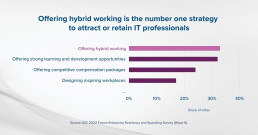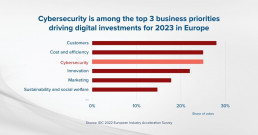Home Office is an Advantage, But Security Risks Remain
Would you work for a company that wants you to spend 40 hours a week at the office? Three years ago, you probably would have raised your eyebrows at the question. But times have changed — and the answer may not be as evident as it used to be.
The COVID-19 pandemic has dramatically altered how we work. Lockdowns and social distancing made the introduction of home office working inevitable for many companies. For a period, this was necessary to keep companies afloat without putting the health of employees at risk.
But home working has now become an expectation for many employees — and it is widely offered by employers to attract and retain workers.
To stay competitive, enabling a hybrid home-office model, full-time home working, or remote working is an increasingly popular strategy for organizations. But it requires the deployment of substantial security measures to limit risks in a digital environment that remains highly threatening.
Home Office: A Key to Attracting Professionals
Our research reveals that companies are using hybrid and remote working models to strengthen their competitiveness. From the employer point of view, offering a home office opportunity can improve employee satisfaction. In many cases, it also boosts productivity, resulting in better products and services and greater customer satisfaction.
Companies want to keep employees motivated — and hybrid working models are one way to do so. IDC’s European Industry Acceleration Survey 2022 found that 37% of the 1,500 respondents regard hybrid working as an external force that positively impacts the organization. Among all listed options, hybrid working won the most support from survey respondents.
Job seekers increasingly prefer companies that enable them to work from home on a regular basis. Many employers have supported this preference to avoid losing applicants. IDC’s 2022 Future Enterprise Resiliency and Spending Survey (Wave 6) offers confirmation: One-third of respondents cited offering a hybrid working opportunity as their top strategy for attracting and retaining IT professionals.
The survey also found that 29% of organizations regard offering a hybrid model as having the most impact of a range of strategies. Offering competitive compensation packages or designing inspiring workplaces were lower-ranked options.
Almost half of respondents said choosing the right strategy is crucial in the recruitment of IT professionals, particularly those who possess key skills that are in high demand.
Same Road, Different Stages
Companies are generally open to taking the necessary steps to satisfy the home office-related needs of their employees. But they are at different stages of introducing hybrid working models.
Around one-quarter of IDC survey respondents said company leadership had expressed interest in learning more about employee perspectives on hybrid or fully home-based working. One-quarter of respondent organizations have introduced short-term policies for it. Nearly one-third have invested in technologies to support ongoing remote and hybrid work based on feedback from employees, while 13% intend to maintain hybrid and remote working models over the long term.
Of course, not everyone has a positive view of home/remote working. But the Future Enterprise Resiliency and Spending Survey found that only a minority of enterprises face a situation in which the leadership and employees have completely divergent views on the subject.
What does home office working cost employers? IT investments, mostly related to infrastructure, are a major spend. IDC’s Future of Work Spending Guide reported that European companies are expected to spend $4.3 billion on remote team enablement this year. Increasing storage capacity and scaling VPN solutions are two of the most common upgrades that organizations implement.
Home Office or Remote Working?
The focus on VPNs illustrates that organizations must address the security risks of working from home. From the security point of view, there is a difference between home office and remote working. In the case of home office, employees are restricted to working in a specified location, their home, using equipment provided by the employer. In remote working, employees may work from anywhere and use personal equipment.
Remote working poses a much higher security risk. Unsafe networks, weak passwords, and unverified software are among the leading risks. People around the employee may also jeopardize the security of sensitive information. At home offices, unsecure networks, employee exhaustion, a sense of comfort and security, and distractions are among the risk factors. Security measures implemented by the employer can alleviate many of these concerns.
Increasing Focus on Security
After data management, cybersecurity is the second-ranked focus area for organizations. More than two-thirds of IDC survey respondents cited cybersecurity as a focus of skills acquisition and training. Having security experts at the company is essential for technology projects. Many respondents highlighted that IT security professionals remain in high demand, especially for key initiatives.
Security is indeed an increasingly crucial sector for investments, especially in the current era of cyberwar. IDC’s Security Spending Guide reveals that European organizations spent more than $42 billion on security technologies in 2021. A nearly 11% increase is expected in 2022.
The results of IDC’s European Industry Acceleration Survey 2022 align with this trend: 32% of respondents regard cyberthreats as an external factor that negatively impacts the organization. It is thus not surprising that 34% of respondents expect cybersecurity regulations to have a major impact on business in the next two years. In 2023, cybersecurity will continue to be among the top priorities driving digital investment.
There are many ways to boost an organization’s cyber-readiness. Among the listed security services in the Future Enterprise Resiliency and Spending Survey, security training received the most votes (33.6%). When working from home, employees leave the secure working environment provided by the office, exposing employers to greater risk of data breaches and cyberattacks.
Increased spending on cybersecurity, however, is not solely due to the risks posed by home and remote workers. Private and the public sector organizations may be targeted for cyberattacks no matter how many employees are physically present in the office. Because an inability to secure sensitive data poses operational and reputational risks, security budgets must not become victim to budget cuts by organizations trying to survive inflation and recession.
Home office has become widely popular and, for many, the default way of working. It remains to be seen whether the rising cost of living will force employees back to the office. But for now, labor market competitiveness depends on whether companies are willing and/or able to satisfy employee demands for home office. And this trend will continue to influence security sector spending.



